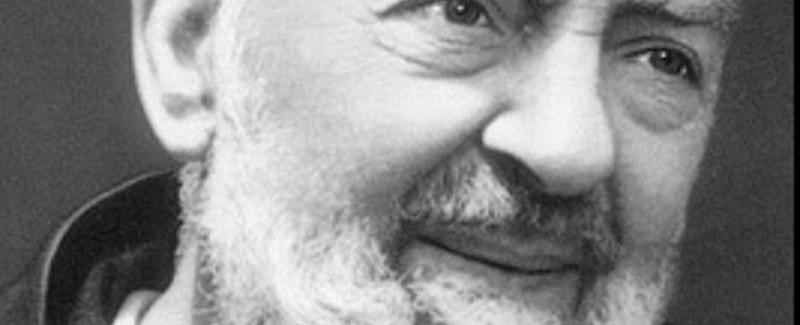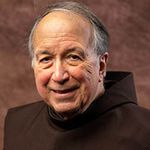Saint Pius of Pietrelcina (Padre Pio): Bearing the Stigmata, Suffering with Christ

On September 23, Catholics celebrate the memory of Saint Pius of Pietrelcina (1887-1968), the Capuchin Franciscan friar still best known simply as "Padre Pio," who has become one of the most popular saints in the Catholic Church.
Fascinated by Capuchin friar
He was born of poor but devout parents, Grazio and Maria Forgione, in the town of Pietrelcina, province of Benevento, in southern Italy, and baptized Francesco. At an early age, he was fascinated by a barefoot Capuchin who came around seeking alms, and Francesco grew up wanting to become a friar but lacked the educational background. His father, Grazio, came to the United States to find work in order to pay for the necessary schooling, and so Francesco entered the novitiate in 1903 and was given the name Pio.

Street scene in Pietrelcina, birthplace of Padre Pio
Plagued with ill health
Brother Pio was ordained to the priesthood in 1910. He was plagued with ill health, leading his superiors to send him home with his family for some years. In 1916 he was able to return to community and assigned to the small friary of Our Lady of Grace in the town of San Giovanni Rotondo in Apulia where he spent almost all the rest of his life.

Padre Pio as a younger friar
Experiencing paranormal phenomena
Shortly afterward, Padre Pio began experiencing paranormal phenomena, especially the stigmata that first appeared on his body in September 1918. These caused considerable notoriety and suspicion, and Padre Pio underwent a long series of investigations by church authorities that ended only in the early 1960s.
Ability to “read hearts”
Gradually the tide turned, however, and Padre Pio’s deep spirituality and ability to "read hearts" brought thousands to his friary for counsel and confession. At times he had 18-hour workdays.

Padre Pio's room in the friary at San Giovanni Rotondo
Stigmata disappears
The friars built a new church in the 1950s to accommodate the large crowds coming to San Giovanni Rotondo. Pio died just days after marking the 50th anniversary of the stigmata. At his final Mass, the stigmata had disappeared.

The Capuchin friary and church in San Giovanni Rotondo in the early 1920s
Confident in God’s love in his life
Padre Pio's life demonstrates again that beneath all the publicity, the heart of Franciscan spirituality lies in a radical response to the in-break of God's love in one's life that leads us to empty ourselves and follow in the footsteps of Christ in humble service. Pio's great confidence in the love of God is typified in his oft-quoted advice to penitents: "Pray, Hope, Don't Worry." For more details on Padre Pio's life, click here.
“Man of prayer and suffering”
As Pope Paul VI told the Capuchin friars not long after Padre Pio's death:
Look what fame he had, what a worldwide following gathered around him! But why? Because he was a philosopher? Because he was wise? Because he had resources at his disposal? No—because he said Mass humbly, heard confessions from dawn to dusk, and was—it is not easy to say it—one who bore the wounds of our Lord. He was a man of prayer and suffering.
Sharing the Suffering of Others
We should remember also that as Padre Pio came to know Christ more deeply and through the experience of his own sufferings, he began an outreach to the suffering poor through a small hospital in San Giovanni Rotondo. By the late 1930s, he began to organize prayer groups to fund this effort, which today has grown into a major medical treatment and research center.
Padre Pio was canonized in 2002 by Pope St. John Paul II, who had first met him in 1947; later, as Cardinal Wojty?a, he wrote Padre Pio in 1962, asking him to pray for a friend of his, Dr. Wanda Poltawska, who was very ill with cancer. She was cured.

The vast complex in San Giovanni Rotondo today: upper right, the large modern pilgrimage church (with green roof) holding the remains of Padre Pio; beneath it, the shrine church of Santa Maria delle Grazie, built in the 1950s, where Padre Pio led prayer; and at the bottom, the "Casa Sollievo della Sofferanza" (the hospital).
Dominic Monti, OFM
Professor of Franciscan Research in the Franciscan Institute of St. Bonaventure University
Dominic V. Monti, OFM, is a Franciscan Friar of Holy Name Province (USA) and currently professor of Franciscan Research in the Franciscan Institute of St. Bonaventure University. He devoted the greater part of his ministry to teaching the History of Christianity, in particular the history of the Franciscan movement. He has contributed two volumes to the Works of St. Bonaventure series and is author of Francis & His Brothers, a popular history of the Friars Minor.

